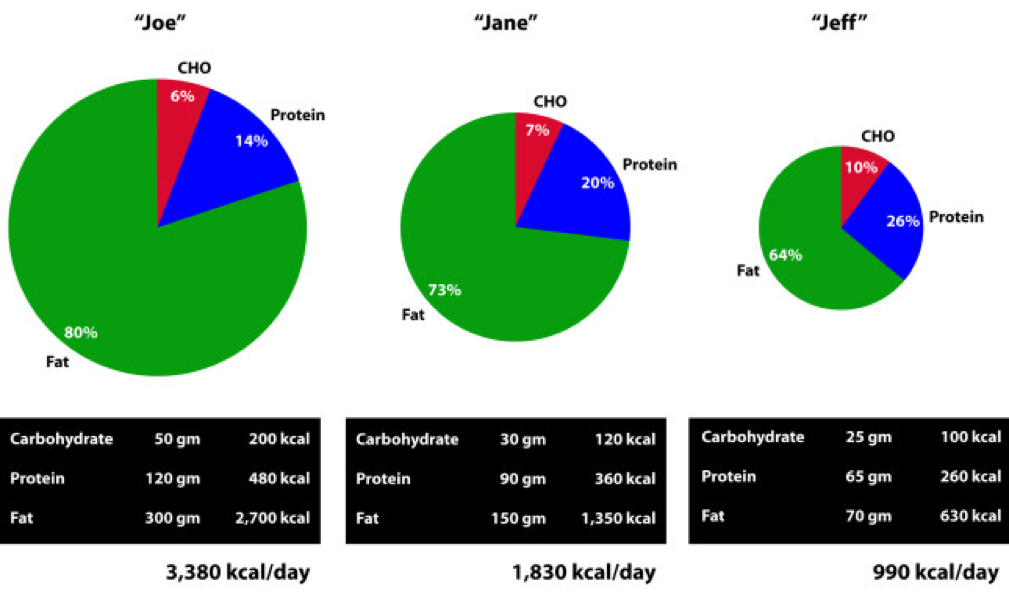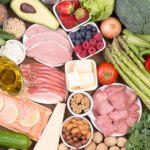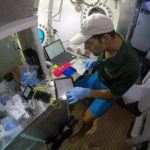For reasons I’m still struggling to understand, the idea of “nutritional ketosis” (NK, to be distinguished from starvation ketosis, SK or diabetic ketoacidosis, DKA) is often discussed and debated in much the same way as religion or politics. Perhaps this can be said of all nutrition, which is a shame. Nevertheless, in my continued defiance of such sensitive topics, I’d like to add another layer of complexity and nuance to this discussion.
The “rule of thumb” for NK is that caloric intake is determined as follows (this excludes a subset of ketogenic diets known as calorie-restricted KD which, as the name suggests, is specifically restricted in calories):
- Carbohydrate (total, not “net”): less than 50 gm/day, but ideally closer to 30 gm/day
- Protein: up to 1 to 1.5 gm/kg, but ideally below about 120 gm/day
- Fat: to satiety
Let me illustrate what this looks like for Joe (left), Jane (middle), and Jeff (right — an example of a calorie restricted KD), three hypothetical people in NK — but each with different caloric requirements.
As a general rule, as caloric requirement increases the proportion of calories derived from carbohydrate and protein decreases (and the contribution of dietary fat increases), even while absolute intake of carbohydrate and protein increases.
Anyone who has bought a blood ketone meter knows how tough it can be to get “into” ketosis by carbohydrate restriction (since everyone asks, I use the Abbott Precision Xtra meter which uses two different strips: one for glucose and one for beta-hydroxybutyrate, or BHB). Most practitioners consider the minimum threshold of NK to be a fasting serum level of BHB above 0.5 mM. I’m a bit more stringent in my practice and like to see fasting BHB levels above 1 mM. To give you a sense of one person’s numbers (mine), over a 6-month stretch in 2013, when I was in NK, my mean (i.e., arithmetic average) morning fasting level was 1.7 mM with a median value of 1.4 mM. The highest morning level during that period was 5.2 mM. (The highest morning level I have ever measured in myself is 5.7 mM.)
But, it took me a long time to get it right, especially since at the outset of my foray into NK I was consuming between 4,000 and 4,400 kcal per day. (My average daily caloric intake for weight stability was about 3,800 kcal per day, which was validated by doubly-labeled water.) I could still easily “fall out” of NK. For example, on my daughter’s 5th birthday she insisted I have some of her tikka masala (contains lots of sugar), naan bread, and mango ice cream. How could I say no to a birthday girl who insisted on going to the nicest Indian restaurant in San Diego? As to be expected, the next day my BHB was 0.2 mM, and it took me 2 days to get back above 1 mM.
Here’s a little secret I’m about to let everyone in on… I like carbohydrates. I love sushi (though I now mostly eat sashimi). I love Indian and Thai food, though I prefer to make curry myself to keep sugar out. I make (and eat) the best hummus this side of the Nile River. I’ve figured out how and when I can eat them to meet the following conditions:
- Stay in NK (except on a few occasions like my daughter’s birthday);
- Increase my anaerobic performance;
- Preserve most (but not all*) of the benefits I enjoyed when I was much more strict about my ketogenic diet.
How, you ask? By learning to calculate my glycogen deficit.
(*) For me, the leanest body composition I achieved as an adult was in strict NK with no attempts to do what I’m about to describe below. Since I’m not a model and nobody cares if my body fat is 7% or 10%, I’m happy to be a little less lean if it gives me the flexibility to increase performance and live a slightly more sane life. At least for now.
PLEASE NOTE: I have never suggested, and can’t imagine I ever will suggest, that a KD is “best” or “right” for everyone. What I describe below may seem extreme, both in the amount of work required and the actual application. I fully acknowledge that (1) this is a highly analytical approach to eating, and (2) that I’m a “freak” (my wife’s words, not mine). I certainly don’t do this often, unless a lot is on the line (e.g., a big ride), but I like having this technique in my armamentarium.
If you’ve watched my presentation from 2013 at the IHMC, then you’re familiar with RQ. Through years of metabolic testing I have a pretty good sense of my RQ at any moment in time – when I’m sleeping, when I’m sitting around (most of the time), when I’m riding my bike at 200 watts, when I’m riding my bike at 400 watts, when I’m lifting weights, etc. This allows me to calculate what proportion of my energy I derive from glycogen and what proportion I derive from fatty acid. Consider the following example:
If I ride my bike at an average of 185 watts (you’ll need a power meter to infer this) for, say, 2 hours, I know my average RQ is between 0.76 and 0.80.
The approximate formula is %CHO = 3.333*RQ – 2.333, which can easily be derived from the observation that %CHO utilized increases linearly from 0% at RQ 0.7 to 100% at RQ 1.0.
Furthermore, I know my VO2 at 185 watts is 2.9 liters per min, which means (using the Weir formula which I presented previously) my energy requirement was about 14 kcal per minute, or 1,680 kcal over 2 hours. Hence, of these 1,680 kcal needed to pedal 185 watts for 120 minutes, 336 to 554 kcal came from glycogen. In other words, I utilized between 84 and 138 gm of glycogen.
(By comparison, several years prior to being in NK, this effort in me would have taken place at a slightly higher VO2 – closer to 3.2 liters per min – and at a much higher RQ – between 0.90 and 0.95 – meaning the exact same work output would have required somewhere between 300 and 400 gm of glycogen! That’s a real state of metabolic inflexibility. Basically, I was entirely dependent on carbohydrates for energy.)
Since the first metabolic priority for ingested carbohydrate is glycogen replenishment, I can, in this setting, consume probably somewhere between 60 and 120 gm of carbohydrate following this ride and stay in ketosis. Why? Because those carbohydrates are prioritized to replenish my glycogen stores AND I am highly insulin sensitive. Note the *AND* in this last sentence. (The especially astute reader will realize some of this glycogen debt will be replenished by protein and glycerol, the latter of which is liberated by lipolysis – see post on fat flux for a primer).
Clearly I didn’t consume this amount of carbohydrate on my daughter’s birthday, so why was I out of ketosis the next day? Because my glycogen debt was not high. Of course, I knew this and didn’t really care. But, if I know my wife wants to go out for sushi one night, and I know she’s going to make me eat a California roll, I can “rig it” such that I show up to dinner with a glycogen debt appropriate enough to enjoy them without significantly interfering with my liver’s BHB production.
Extreme example
At one point, I did two tough bike rides on consecutive days. Each day we rode 110 miles under challenging conditions. Over 6,000 feet of climbing each day and very strong winds, which were either headwinds or cross-winds. On top of this, we rode pretty fast. For the purpose of illustration I recorded everything I did and ate on the second day, which I rode a bit easier than the first day.
The second ride took 6 hours and 5 minutes. My average normalized power output was 225 watts, and arithmetic average power output was 184 watts. Based on mechanical work output, this required about 5,000 kcal. Factoring in the other 18 hours of that day, my total energy expenditure was about 6,800 kcal for the day, obviously not an average day. (A detailed explanation of where the extra 1,800 kcal were expended is beyond what I want to get into now, but it’s basically the energy required to keep me alive – transport ions, contract voluntary and involuntary muscles, etc. — plus move me around, and digest food).
So what did I eat that day?
- Breakfast (pre-ride): 5 scrambled eggs, 2 sausage links, 3 pieces of bacon, coffee with cream.
- In ride nutrition (I spread this out over 6 hours): 14 oz (not a typo) of salted cashews, 2 Quest bars, 1 peach, 1 apple, 6 bottles of Biosteel High Performance Sports Drink, water. (Since I know someone will ask, I did not consume super starch this day since I was craving cashews as my carbohydrate source and was craving more sodium, given the 90+ degree temperature.)
- Late lunch/early dinner (post-ride): 2 oz ham, 3 oz pulled pork, large salad with oil and vinegar dressing, 2 slices of cheddar cheese, 6 mini hamburger patties, 2 tomatoes.
What did this amount to?
- Fat – 351 gm, or 3,160 kcal of fat
- Protein – 245 gm, or 980 kcal of protein
- Carbohydrate – 321 gm, or 1,284 kcal of carbohydrate
(I used package information and Nutritionist Pro software to calculate this.)
Hence, on this day I consumed about 5,400 kcal in total at the following ratio:
- Fat – 58%
- Protein – 18%
- Carbohydrate – 24%
By all conventional wisdom I should not have been in ketosis the next morning, right?
The following morning, my BHB level was 2.2 mM and blood glucose was 5.1 mM.
Teaching point I can’t resist: Following 2 days of significant caloric deficit, about 3,000 kcal in total, I should have in theory lost about a pound (mostly fat, possibly some muscle) which would have been noticed on a scale. Instead, I gained 8 pounds over those 2 days! Sure it was mostly water retention, both from the glycogen (small) and the fluid accumulating in the interstitial space (“thirds space” fluid losses, large) due to a systemic inflammatory response. This happens under extreme conditions of exercise. In fact, the harder I exercise, the more weight I gain, transiently. I am at my absolute lightest following 2 days of travel (i.e., rest). So before freaking out at the sight of the scale, keep in mind that most day-to-day weight movement in our bodies is indeed water movement into and out of the plasma and interstitial space, respectively.
What’s my point?
Context matters! If I ate even one-quarter of that amount of carbohydrate and two-thirds of that protein on a normal day – say, 2.5 hours of riding or 1.5 hour of riding followed by 1 hour of swimming, or a day of travel with no exercise – I would have been out of ketosis for two days or more. (Of course, my appetite on those days would not have allowed me to eat 5,400 kcal without feeling sick, but I won’t get into that until a later post.) But on this day, with these glycogen demands, I was able to maintain the perks of ketosis AND glycolysis simultaneously.
There are days, though, when I overshot my glycogen need and end up with a low BHB and high fasting glucose the following morning. Conversely, there are days I underestimate my glycogen depletion and wake up with very high BHB levels and very low glucose levels (i.e., BHB levels higher than glucose levels, when both measured in mM).
Final thoughts
I felt a bit like I was in unchartered territory because the literature on nutritional ketosis hadn’t really (to my reading) explored this level of extreme activity. In future posts, I may write about other experiences and self-experiments, including my experience with exogenous (i.e., synthetic) ketones (which I did not use on this ride, but have experimented with on other rides – no, this is not “raspberry ketones” or other such gimmicks).
2017: You can read about one of my earliest experiences with exogenous ketones in this post.
Are carbohydrates necessary to produce 225 watts or more for hours on end? Yes. But, the key is knowing how much you need and when to take them. A lower RQ at a given level of intensity means less demand on glycogen. In my experience, working with athletes and non-athletes, most tend to make two errors (for lack of a better word):
- They over-estimate their carbohydrate requirement, and/or
- They forget that no factor influences RQ – and therefore substrate requirement – more than dietary composition during lead up to event (or “life”, which is sort of the ultimate event).
Know your engine, first. Then fuel it appropriately.
Photo by CloudVisual on Unsplash







Hello Peter, I’m running on Ket for the last 3 weeks. kindly inform me what I should have during extreme sports like XC MTB racing for around 3 hours….
Beginning a Ketogentic style of eating, and starting to train for a half marathon. Can I use one scoop of UCAN before my runs starting out until I am keto-adapted? Or will using UCAN in the early stage keep me from being keto-adapted?
Dear Dr. Attia, I have a question that maybe only you can answer, being that you have studied the topic closely and have done more self experimentation than just about anyone. I follow a ketogenic diet much (but not all) of the time. Normally my fasting glucose is 95, consistently for several years. Recently I went to the ER with what turned out to be a kidney stone (my first). By the time I was seen I had been in severe pain for 3 hours. I had fasted that morning. My blood test revealed positive ketones (2+) and glucose 142. Now my PCP says I am diabetic. I asked her whether being in severe pain would drive up the glucose. She says ‘no’. Is it possible that I have suddenly become diabetic? It seems more likely to me that the severe stress is what drove up my glucose: fight or flight! I appreciate your comments. I have searched the internet for clues about this but have come up empty.
What? Of course severe pain–or any physiological stress–can and does drive up glucose. Stress –> cortisol –> hepatic glucose output –> higher blood glucose. I’m sure (I hope) your PCP just misunderstood your question.
Thank you very much for your response! She was not answering a question, actually. She was looking at a lab report and telling me her interpretation/diagnosis. I was very surprised that she concluded that I was diabetic based on a single lab, and especially under the circumstances. Since then I did a self-experiment: 3 reasonable meals spaced evenly throughout the day, 16 glucose measurements, and I am happy to say that my glucose response is perfectly normal, starting at 90, maxing out at 148 after dinner and returning to baseline within 2 hours consistently. I hope she will learn from this not to alarm a patient unnecessarily, but I am concerned that she would jump on a diagnosis like that.
Hi Peter. I have tested exercise after 2 to 4 days of fasting (just water plus electrolytes). My blood glucose is stable around 3.5 mM. Then, I resume eating with LCHF (less than 50 g of carbs per day, and on day 4 my blood glucose is back to 5 mM. Am I still is ketosis? (I did not check for blood ketones). Should not my blood glucose stay in the 3.5 mM range after fasting and LCHF? Thanks for your feedback. And BTW, your site is really precious.
Blood sugar isn’t sensitive enough to predict magnitude of ketones in blood.
Hi Peter,
Very intersting information. Thanks for sharing.
I have recently changed my food habits (5 weeks) right after the Boston marathon. I have cut the carbs to 50g a day and increased the fat intake to 200g a day. When i measure my ketones i’m between 0.6 and 1.1 using novamax.
My question: i do not seem to be able to recover from the Boston marathon where my legs are still heavy and my muscles are still sore. Usally it takes me 2 weeks to recover from a marathon. I’m wondering if this inability to recover is related to my adaptation (or lack of) to a high fat low carb diet. I have reduced my training and removed the intervals in the hope of recovering but I do not seem to Recover. Your thoughts would be appreciated. Thank you
I’m an IF dieter (16:8 to 20:4) and also will sometimes go low carb for breakfast and lunches when I eat them to maintain weight. I run 3xweek and lift 2xweek. I’ve found I can do a lot of physical activing taking the UCAN SS when working out while fasted and not have any GI issues also. You still use the stuff?
I do still use UCAN SS for meal replacement shakes from time to time (incl yesterday!).
There is now starting to be a flux of extrogenous Ketones available on the market that claim to get you into the state of ketosis. I know personally I benefit from them with endurance activities, but do they actually put you into a quick state where you burn your own ketones (or fat) for fuel?
Thank you
Hi Peter,
I was wondering what is the benefit of MCT oil then with high carb/ high protein diet. I am doing weight lifting and cross fit and would eat around 300gm of complex carbs over the day to gain mass but cut fats at the same time, but I am for sure wouldn’t be burning as many calories as in your extreme example where you consumed 321gm of carbs.
My nutritionist advised me for MCT oil, and I am trying to relate it to ketogenic state, but can’t get it. Or perhaps it is for another purpose that I am not aware of.
Do you have any thoughts? any benefits from having MCT oil with high carb diet?
Thanks
Hi Peter, I discovered your blog recently and I wanted to thank you for your clear articles. I’ve got a few questions if you don’t mind:
I don’t need to lose weight, but I wanted to try a moderate LCHF diet because it seemed mostly beneficial, and I’m quite looking forward to stop being an addict to sweet things. However, as I’m still a student and I don’t live independently, I cannot always eat what I want. I wanted to ask you if following a LCHF diet when I have to eat two or three high-carb meals per week is fine or dangerous, as I’ve read that high carb intake added to high fat intake is a very bad option. Particularly, I often eat Asian meals, so there’s either rice or noodles in them.
Also, I’ve tried to search the web for the impact of fruits in LCHF diets, because I find it a shame to give up on many fruits, and I’m not sure to understand whether fructose is okay or not. What is your opinion on this?
Hi Peter
I have just subscribed and am finding the content of the blogs extremely interesting and educational.
I’m a relative new comer to the concept of the KD and NK and have been adapted to it for about 3 months now.
I’m a competitive open water swimmer and looking to try and combine the benefits of having glycogen stored in the muscles and also access to fat stores for sustained pace over a race (1.5km-2km). My calorie requirements for this is roughly 500kcal to 700kcal.
From reading your article ,is my understanding correct that you were able to enjoy the benefits of using both ketones and glycogen by drip feeding carbs during during the activity?
If this is the case can this be done in open water swimming, as the only opportunity you would have to take in the carbs is before the race, however I would think this would spike insulin and hault the production of ketones?
would another viable option be to load up on some carbs two days before a race, just after training, then fast the following day to get back into ketosis for a race the day after fast day? I have never tried this but I am contemplating it, but at the same time I don’t want to mess the progress I have made thus far?
Interesting article. When I first started ketosis, I was able to get a blood reading as high as 1.1, and by first started, I mean in the first week or two. Since then, I’ve been lucky to hit 0.4. Usually my meter just reads “low” (which means less than 0.1). I keep my carbs to less than 50 total, and often less than 25 total. My protein is 80-100g. My fat intake is 100-120g. I bike, run, and lift weights 6 days a week. My body just doesn’t produce excess ketones. I make just enough to use I guess. My blood glucose is always upper 70’s to lower 80’s mg/dL (I’m not diabetic). I’m not sure why high levels of ketones in the blood are important.
CGM to measure. Optimization is context specific.
I wrote about my experience here:
https://peterattiamd.com/what-i-actually-eat/
Great Article! I found out, by accident, that the glycogen deficit did not affect my ketosis.
After 4 weeks into my first attempt at the keto diet, and after getting my ketone levels above 1.0mM, I decided to do my first long ride (6hours) while having fasted for 16 hours by the start of the ride. I felt awesome throughout the ride. No hunger, full of energy, no real fuel besides water & BCAAs, and surprisingly NO leg burn. Just a continuous spinning of the pedals…
At the end of the ride I measured my ketone levels – 5.2mM. Wih a caloric deficit of 6,500 calories I decided to spoil myself with pizza and a few beers. The next morning, my ketone levels were @ 2.3mM.
Since then, I’ve opted to train fasted, and enjoy some low GI toast with with butter and jam just to enjoy some carbs, or I’ll do some some power training sessions before a night out in town so I can enjoy a few cold ones!
Looking for a more detailed explanation on why not “Net Carbs” and am having trouble finding one from a trusted expert.